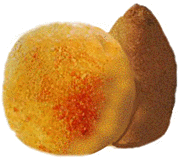Arancini - Arancine - Rice Balls (original) (raw)

 Arancine (rice balls) were invented in the tenth century during the Kalbid rule of Sicily. Stuffed with meat and coated with a light, crispy batter, rice balls are similar to foods based on recipes known in the Middle East during the Middle Ages. Their Italian name comes to us from the word for orange (arancia), which they faintly resemble in colour and texture. Nowadays the arancine made in western Sicily are round while those made in eastern Sicily (particularly around Catania) are often conical.
Arancine (rice balls) were invented in the tenth century during the Kalbid rule of Sicily. Stuffed with meat and coated with a light, crispy batter, rice balls are similar to foods based on recipes known in the Middle East during the Middle Ages. Their Italian name comes to us from the word for orange (arancia), which they faintly resemble in colour and texture. Nowadays the arancine made in western Sicily are round while those made in eastern Sicily (particularly around Catania) are often conical.
This all seems fairly simple, though preparing arancine (or arancini) well is something of an art. But how did rice arrive in Sicily in the first place? It's certainly not grown here today. Rice (as well as oranges) was introduced during the Arab period. Of course, rice cultivation requires water. The Arabs built innovative and very efficient irrigation systems in Sicily, but the island was naturally grrener then. The climate was cooler and there were larger forests. There were also more streams that flowed year round (instead of the run-off torrents seen today), navigable rivers and natural lakes. In such an environment the Arabs revolutionised agriculture and introduced crops such as cotton and sugar cane.
The cultivation of rice in Sicily had no connection with rice farming in Piedmont, a sub-alpine region of northern Italy where arborio and other rice varieties are still grown. The introduction of rice in Sicily parallels that in Spain.
Arancina rice is flavoured and coloured with saffron. Though cultivated in antiquity in Greece and Sicily, the widespread use of this yellow spice was more prominent in medieval Arab cuisine, and is used in preparing paella, a Spanish rice dish. (Saffron was also used as a pigment in medieval painting.)
Arancine are formed of cooked and flavoured rice shaped around a core of chopped meat filling. The balls are then coated and deep fried to a crisp. Arancini are not the only crispy fried Sicilian food introduced by the Arabs. Pannelle come to mind. These are flat cakes made with ceci flour.
Rice balls are the golden jewel in the crown of Sicilian cuisine.
About the Author: Palermo native Francesca Lombardo is Best of Sicily's resident wine expert. She has written a book about Sicilian street food.